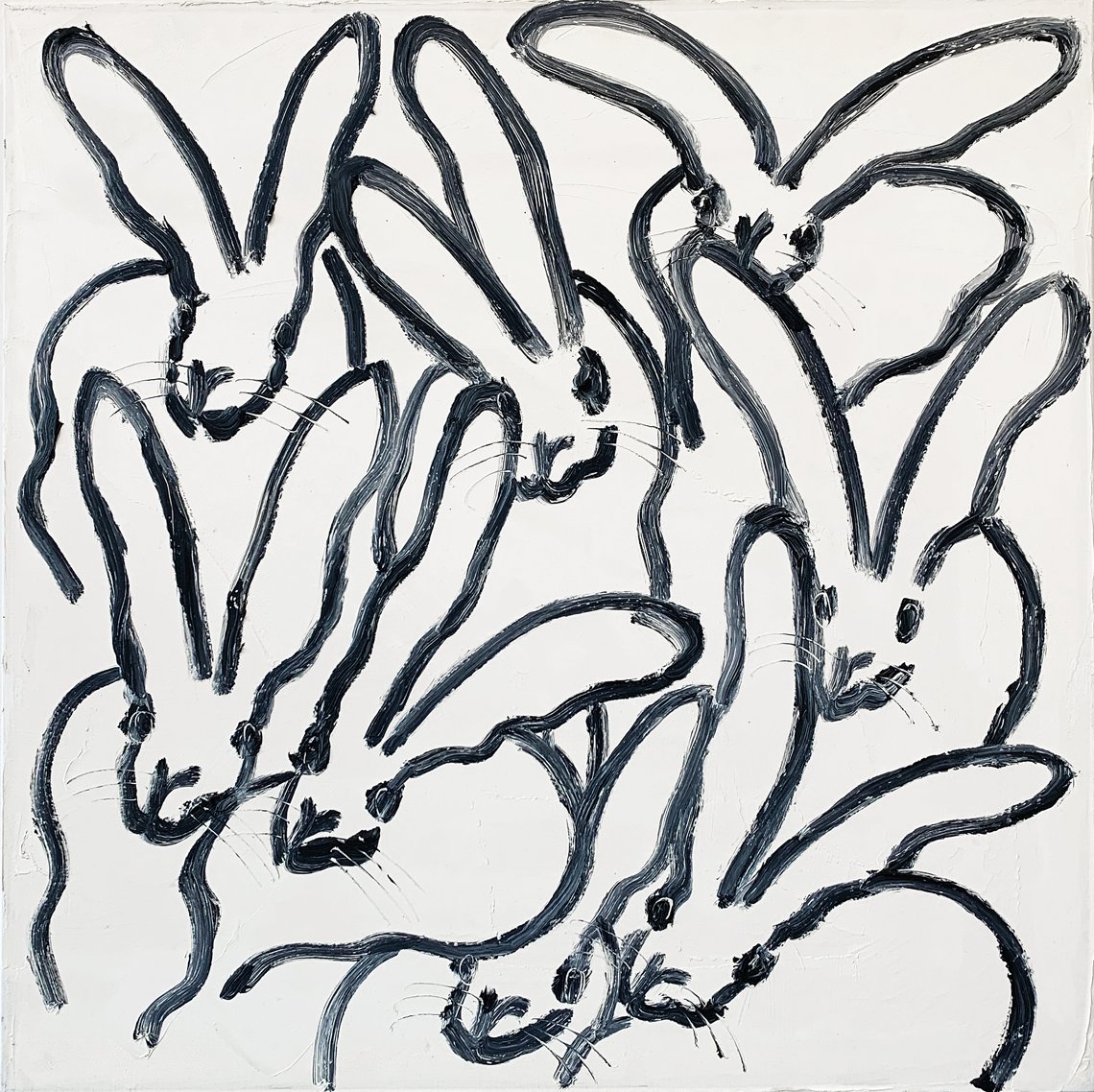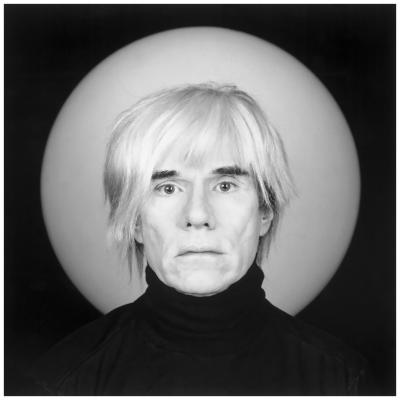Hunt Slonem on the Mystical Pleasures of Bunnies, Butterflies & Birds
 |
Hunt Slonem. Photo by Charlie Rubin. |
“I talk to mystics a lot about bunnies,” the artist Hunt Slonem says, “and one of them once said to me that rabbits would take me to places I have never been. It was true.”
He pauses and then adds, wryly, “I am sure you don’t find that credible.”
Slonem, at 71, has spent the last five decades producing paintings of rabbits, birds, butterflies, and tropical fauna and flora collected by museums and celebrities alike: the Guggenheim, the Metropolitan Museum of Art, and the Whitney, the King of Bahrain, Jay Leno, Sharon Stone, and Whoopi Goldberg. He is eccentric, a maverick with a penchant for owning historic homes — six at the last count, the most recent being Searles Castle, a 60-acre estate with a 40-room, 7-floor mansion from the 1880s located in the heart of Great Barrington, Massachusetts.
 |
Hunt Slonem, JJS, 2019. Oil on canvas, 30 x 30 inches. |
 |
Hunt Slonem, Pink Ascension (1951), CX1989, 2022. Oil on canvas, 30 x 30 inches. |
Slonem is busier than ever and shows no signs of slowing down. He is working on a dozen private commissions for clients all over the world along with an exhibition of monumental mosaic-on-metal sculptures (his latest passion) for New York’s Botanical Gardens, which will open in 2024. In the meantime, he has an exhibition in Singapore this summer, and in September a show in London and a museum show in Vienna.
Born in Kittery, Maine in 1951, Slonem grew up in New England and later Hawaii where as a child he was introduced to the tropical fauna and flora that have dominated his artwork — and life — for 50 years. “In Hawaii, I saw the Iolani Palace as a child and Queen Liliuokalani’s Gothic furniture. This had a big impact on me along with the natural environment there. I keep birds and have had up to 100 birds of various species at one time including over a dozen toucans and parrots,” he tells me. He has also had, as pets, turkeys, snakes, and monkeys. In addition to his aviary, his homes and art studios are festooned with various orchids and all kinds of verdant tropical plants.
 |
Hunt Slonem, Morphos, EA01794, 2019. Oil on wood, 25½ x 30 inches. |
Slonem went to school in the South — he earned a degree in painting and art history from Tulane University in New Orleans. He always works in oil paint and prefers to paint on board. “I prefer to paint on wood. I like the way the paint adheres and the way the brush touches the surface. I don’t like the way the brush bounces off canvas but I use it for my bigger works.” He applies many coats of gesso to the board and paints into the wet gesso, similar to the method used in painting a fresco, and scrapes in a cross-hatching pattern through multiple layers of wet paint using the end of a paintbrush to create a surface texture that resembles a tapestry or weaving.
Slonem came to New York in the early 1970s at the height of the Pop art era (his brother worked for Andy Warhol) and this influenced his subject matter and style. He had his first show the next year at the Fischbach Gallery which at the time showed important artists, including Alex Katz. He has been showing his work with galleries ever since and today lives and works on New York’s Upper West Side, in addition to visiting his homes all over the country. “There is so much stimulation in New York, whether you participate or not there is a great energy here. You meet everyone.”
 |  | |
Left: Hunt Slonem, Monsoon, KFJ03144, 2019. Oil on canvas, 36 x 30 inches. Right: Hunt Slonem, Run. Oil on wood, 10 x 8 inches. Courtesy of Whistler Contemporary Gallery. | ||
 |
Hunt Slonem, Ascension Blue & Gold Shiva. Oil on canvas, 50 x 70 inches. Courtesy of Whistler Contemporary Gallery. |
Birds and butterflies were Slonem’s original iconic images, usually depicted in rows or arranged in repetitive and geometric compositions. “I am known for the bunnies but actually, I have been painting birds for 50 years now. I study the species, reading up on the birds that I paint to understand everything about their shape, color, and form and even the outside that they make. They are an endless source of fascination to me.”
But he started out painting people, specifically religious figures which oddly enough led to the bunnies. “I was painting pictures of Christian saints and I just put bunnies at the feet of the saints and people seemed to really like them.”
It was 1973 and Slonem liked to do ‘warm-up’ paintings. He would start his day in the studio with bunny paintings on board just to loosen his hands and get into the groove of painting. He had gathered over the years a collection of grand, old ornate painting frames, and on a whim, he put the bunny paintings in the frames and hung them on the studio walls. Friends and visitors to the studio started asking to buy them.
 |  | |
Left: Hunt Slonem, Chattanooga. Oil and acrylic with diamond dust on wood, 10 x 8 inches. Courtesy of Whistler Contemporary Gallery. Right: Hunt Slonem, Aquamarine. Oil and acrylic with diamond dust on wood, 28 x 22 inches. Courtesy of Whistler Contemporary Gallery. | ||
Slonem tells me that he painted bunnies because of their association with mystics and religious rites. “There is a lot of Interesting folklore that is connected to rabbits,” he says. “They have been mystical creatures for centuries and appear in all kinds of literature such as the White Rabbit in Alice in Wonderland. I view them as a kind of transcendental creature with the power of connecting us to different realities.”
Slonem’s bunnies are rendered less as figurative forms than abstract ideas. They are painted hurriedly, with ease and fluency, resembling fleeting glimpses of real bunnies caught momentarily at night in car headlights or glancing ever warily at us from under a hedge before scurrying away.
 | |
Hunt Slonem, Bayou Casino Lories, CRK01874, 2015. Oil on canvas, 48 x 36 inches. |
There is no real flow to what Slonem does when he paints bunnies, he relates, it just evolves naturally. “I just paint,” Slonem says, “it has simplified things for me. I started out painting the bunnies more representationally but now they are more gestural.” His materials have changed over the years. “Back in the day one of my dealers gave me diamond dust and suggested I use it so I was into that for a while — I helped one of Warhol’s printers make one of his diamond dust paintings once.” But beyond that, he says he just lets whatever happens to happen with them — color, scale, form.
The paintings of bunnies are enormously popular both in America and internationally and sell extremely well. He has shown in more than 350 galleries and produced, at last count, he estimates, over 1,000 bunny paintings in addition to artworks devoted to other subjects. “The odd thing is that nobody ever buys just one bunny painting as they look better shown in groups,” he says. “I’ve had people walk into shows and buy the whole wall of paintings. I’ve even had princesses ask for hundreds of bunny artworks at once.”
His dealers agree. “Hunt’s whimsical animal works have been an incredible highlight of Whistler Contemporary Gallery for many years,” says Jenna Shamoon, assistant manager at the gallery. “Our visitors always stop to admire his works, loving the color, texture, and playfulness imbued in the pieces. And they appreciate the fine craftsmanship and technique that has made Hunt’s work so singular.”
 | |
Hunt Slonem working in his Manhattan studio. Photo by Allison Dayka. |
Slonem's life is an expression of his art, as well, from his extensive wardrobe of bespoke finery, particularly brocade jackets, to the decoration of his homes. He is an obsessive collector of furniture and decorative arts. “I do installations with furniture in my houses,” says Slonem. Fifty trucks were required to move his furniture alone into Searles Castle in 2021. He has a lot of 18th-century American furniture, he says, but it’s mostly 19th-century furniture. “Many pieces are from the English Regency (1811–1830) period, others more mid-19th century, dark, heavy and Victorian, classical revival referring back to earlier styles.” Gothic Revival is one of the styles he likes the most. “I have hundreds of Gothic chairs and sofas and other things. I like mixing my work with all of this stuff and the frames on the bunny painting help that happen.”
Slonem's most recent book, The Spirited Homes of Hunt Slonem, published by Gibbs Smith with a foreword by his friend and collector Whoopi Goldberg is a fascinating look into his many residences. “My decorating style is called maximalism, I am told,” he says, laughing. He loves patina and prefers to keep antiques in the original condition in which he finds them, but re-covers them with his own fabric designs. “I don’t want things to be perfect. I like a little character, and the history that comes with that.” The same goes for his houses. “I don’t repaint very often. I like to show that the houses have age. My bedroom in my home in Louisiana hasn’t been painted for 125 years.”
 |
by Benjamin Genocchio |
 |






























